Tile "under the metal" appeared relatively recently, so immediately brings to the interior notes "high-tech"The apron in the kitchen is not only a fragment of the wall above the working area, which serves to protect the walls from fumes and pollution, but also an important part of the interior, which can be its bright accent or merge with the overall design of the room.
Major overhaul of the kitchen implies the creation of a new, modern, hygienic, fashionable and comfortable interior, an important detail of which is the kitchen apron, which is created not only to protect the walls from pollution and fumes, but also is an important component of the interior.
Traditionally, it is customary to use ceramic tiles to build a kitchen apron. It is very practical, durable, easy to clean and not subject to abrasion. But in addition to a chic assortment in the choice of tiles, now there are many other design solutions, some of which can greatly exceed all the positive qualities of the usual tiles.
So, from what to make an apron and what design is actual today?
Functions of the kitchen apron and its design options
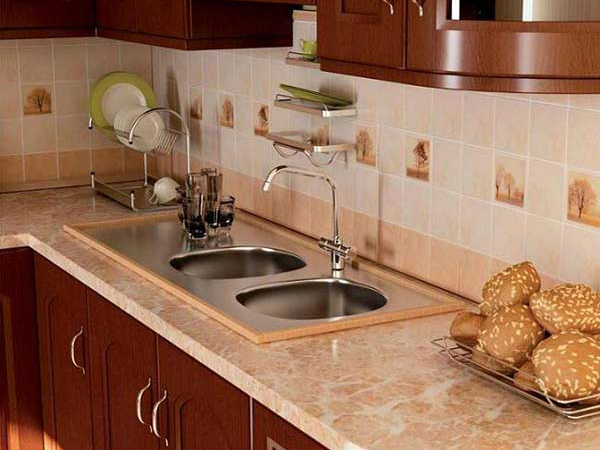
Kitchen apron is created in order to perform three main tasks:
- Protect the wall above the working area from water vapor, moisture and contaminants;
- Maintain cleanliness in the room (the materials from which the kitchen apron is made are easy to clean);
- Be a stylish interior detail.
Today often set contrasting aprons to emphasize the originality of the interior. But, in this case it is important to find the ideal solution, so as not to create a discord in shades and textures.
Some designers prefer neutral aprons in quiet and inconspicuous colors against the background. The most applicable pastel, beige, dairy and other delicate shades.

There are many different types of design for the kitchen apron. In addition to the usual tiles, the area of the wall above the working area of the kitchen can be lined and from something else. Apron for the kitchen can be made from:
- Composites;
- Glass;
- A natural stone;
- Lining;
- Mosaic;
- Pebbles;
- Masonry made of facing bricks;
- Metal.
We will disassemble what kinds of kitchen aprons happen and how best to design its design.
Kitchen apron made of MDF
 A similar apron will fit perfectly into the kitchen of "country"
A similar apron will fit perfectly into the kitchen of "country"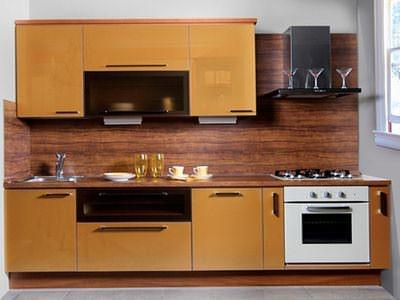
To make an apron for kitchen from MDF, it is necessary to use a laminated fibreboard of medium density. The material is environmentally friendly, since the compound does not contain harmful substances.
Advantages of an apron from MDF are as follows:
- Plates are easily mounted, an apron from MDF can be installed in a short time independently. For the device such an apron does not require the use of long hardening adhesive compositions.
- The panels have a light weight, are easy to handle.
- Apron from MDF is easy to clean. The material is covered with a protective and decorative layer, which does not allow moisture and is not afraid of the effects of household chemicals, and the surface of the apron is very smooth and, moreover, seamless.
- The coating for MDF boards has a wide range of colors and shades, textures and patterns, which makes it possible to make the design individual.
A kitchen apron made of fibreboard can imitate marble, brick, mosaic, tiled masonry and any other materials, bearing not only a visual character, but also repeating the outlines of textures.
- It is heat-resistant, does not warp under the influence of steam or hot water. An apron from MDF can be safely installed above the hob.

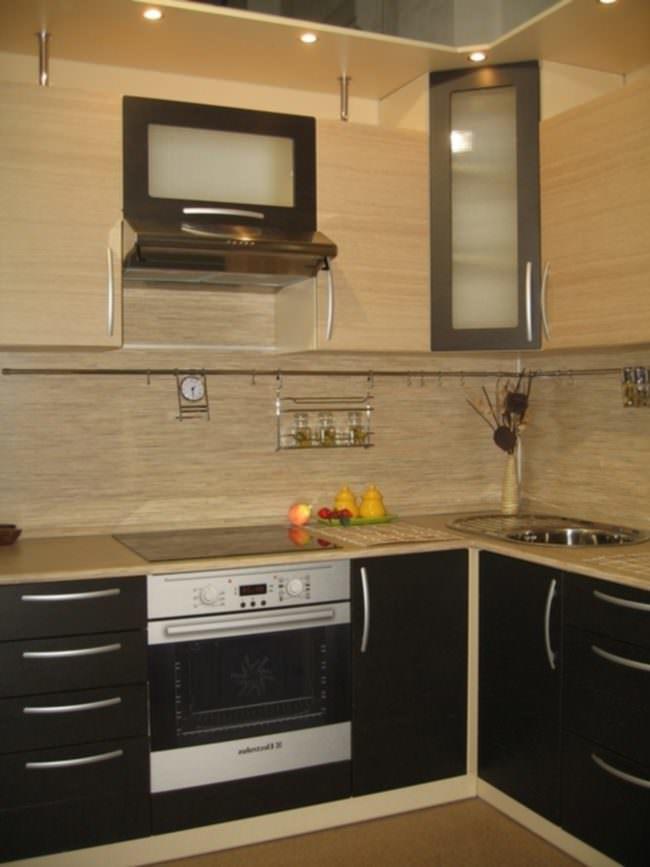
The main flaw of the kitchen apron from MDF is its insufficiently high strength. By its structure, MDF is not endowed with resistance to heavy impacts by heavy objects. Also, wood is easily flammable, which prevents the use of aprons from MDF in kitchens equipped with gas or hotplates. For the device aprons in similar kitchens, you can use composite panels, which are based on MDF, and their laminated surface is finished with stainless steel. But they are much more expensive. Make the same apron from MDF with their own hands is easy.
Glass apron for kitchen
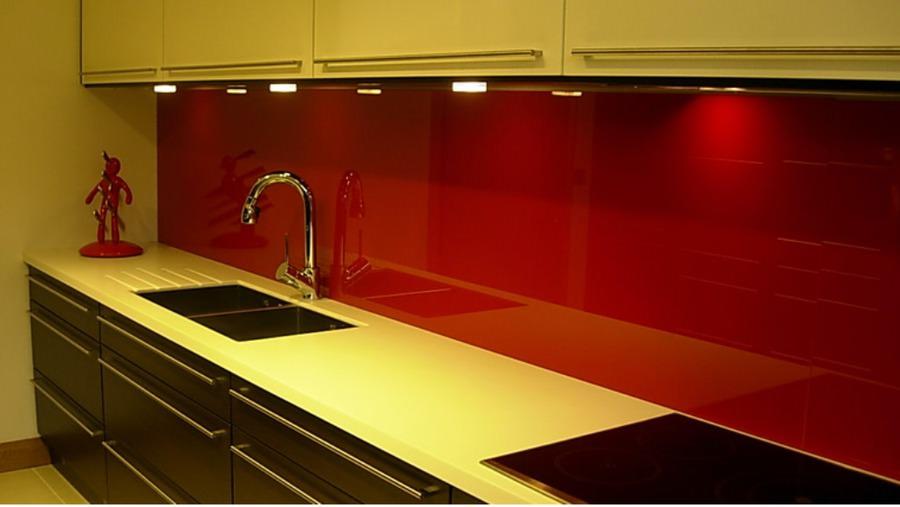
To make an apron of glass, usually use ordinary, quartz or silicate glass. Also there is a smoky opaque, mirror glass or glass with photo printing - this makes the design of the kitchen very original.
In rare cases, aprons made of plexiglass are made on individual projects, but this material is rather impractical: it is not resistant to mechanical damage, eventually fades and, moreover, is difficult to clean.
The existing stereotype that glass is a fragile enough material to be used for such purposes can easily be broken if one knows The main advantages of modern glass panels (in contrast to Plexiglas):
- The glass apron is durable and durable;
- The glass is easily cleaned of dirt;
- Kitchen apron of glass is resistant to scratching and other mechanical influences;
- On the panels, there is practically no noticeable pollution;
- Over the long years of operation, glass will not lose its original appearance;
- The glass apron can be cleaned with chemicals;
- Glass used for these purposes is not afraid of temperature changes;
Panels made of glass are difficult to break, but if this happens, the glass will scatter into small particles that do not pose a physical hazard.
- Glass kitchen panels can have a variety of designs and varieties from transparent glass, followed by a general finish of the kitchen walls, to the engraved mirror or tinted surface. This allows you to maximize the individual design of the kitchen;
- Behind the glass panels of the apron you can hide the illumination of the working area, which harmoniously fits into the overall design of the kitchen.
Mosaic application

Mosaic is an excellent way to protect the walls of the working area of the kitchen from pollution, besides, it gives the interior design a certain sophistication. The mosaic coating can be made of ceramics, glass or metal. According to the old technology, a "Venice" mosaic is made from smalt. The method of its production is the addition of metal oxide to pieces of ordinary glass. Venetian mosaic is much superior to other coating options in aesthetic and practical terms. When changing lighting, it can change shades, like a chameleon.
To make an apron from a mosaic is not more difficult, than from a tile. Differences only in scale.
Kitchen apron from tile
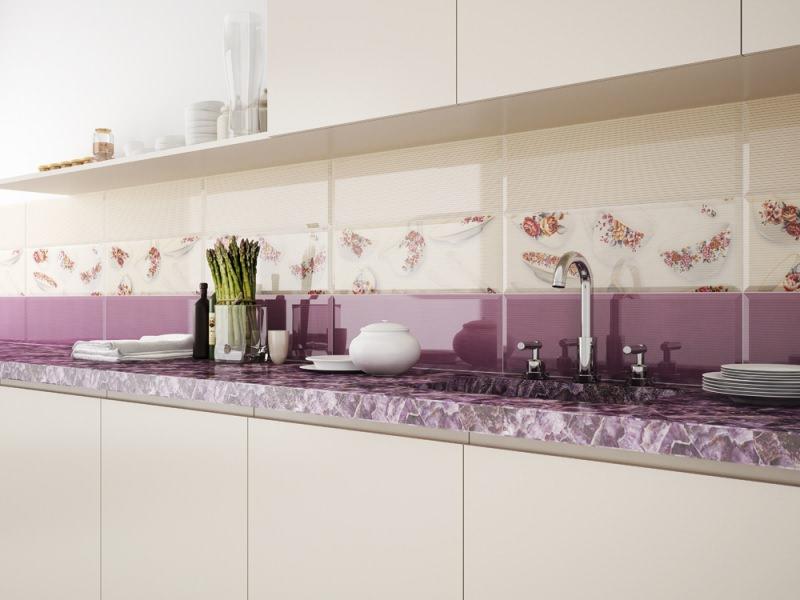
Ceramic lining or tiles from porcelain stoneware are quite popular material in the decoration of kitchen aprons. On sale it is possible to find a tile of any configurations, colors, sizes, drawings and design as a whole. For many years, tiles are kept on a par with other finishing materials due to such advantages:
- Strength;
- Moisture resistance;
- Heat resistance;
- Ability not to absorb contaminants;
- Ease of care;
- Practicality;
- Variety of choice of shapes, colors and textures.
It's quite easy to make an apron of tiles.
The disadvantage of tile is that its laying takes a long time, careful approach and application of certain efforts. In addition, the apron from the tiles can not be started immediately after installation: the tile adhesive must dry, and then a long and scrupulous process of joint processing follows. The surface to be laid should be even. If for any reason it is not possible to level the wall for laying the tiles, you can glue the sheet of particleboard, plywood or drywall with a tile, and then attach it to the wall as a finished panel.
A natural stone
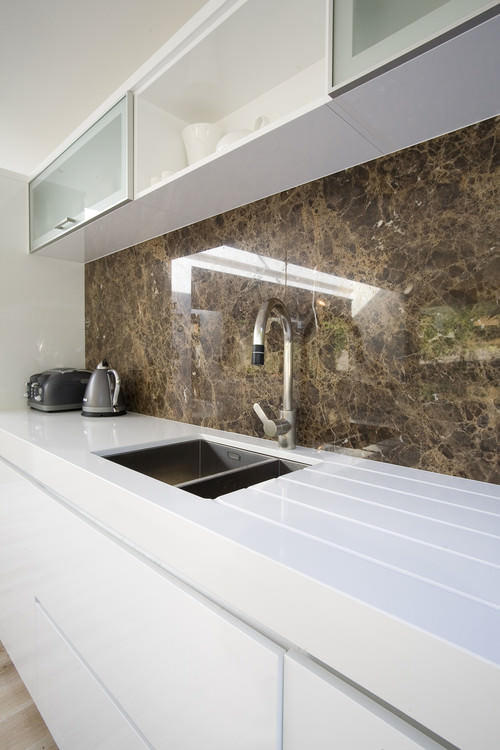
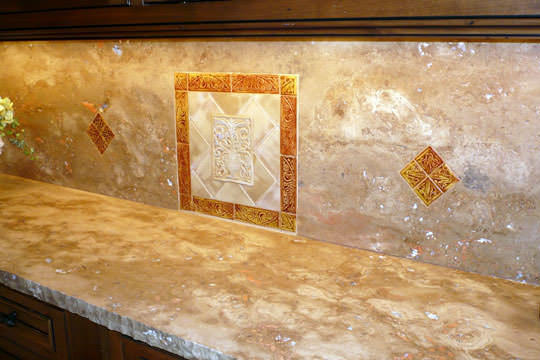
Natural stone is a very beautiful and attractive material.
The design of the stone apron in the working area of the kitchen will always look stylish and unique, as the stone almost never goes out of fashion. It is famous for its durability and strength and is an environmentally friendly natural material.
The structure of the stone absorbs all kinds of pollution, therefore, to protect the stone apron, it is recommended to use a special coating based on wax. Panels made of stone require careful and accurate handling, since the material is brittle and when applied by heavy objects, cracks and chips may form. For a kitchen apron, stone slabs are used, the thickness of which is at least 2 cm from granite or basalt.
Pebbles
In addition to an excellent solution in the field of landscape design, sea pebbles are an excellent decorative material for the construction of unique interiors, the design of which is admirable. With the help of pebbles, you can decorate not only fragments of walls, but even furniture, provided that the overall design of the room does not necessarily have a marine character.

Sea pebbles - the original material for creating a unique interior of your house ...
Before gluing on the wall, the pebbles are subject to careful selection in size, washing and drying. After the finished surface has solidified, the pebbles are cleaned of the glue residues and covered with a protective layer of colorless varnish. But the kitchen apron is often to be cleaned and pebbles in this case may not be very convenient to use. In this case, there are two solutions:
- Pebbles from pebbles can be covered with a transparent glass, not forgetting to organize behind it a light from the LED cable. To complete the composition "behind the glass" you can add artificial algae and other characteristic elements of the decor. Such exclusive design of the kitchen apron will look rather exquisite, besides such an apron will not bring difficulties in the care.
- Also, to create an unusual apron for the working area of the kitchen, you can use already prepared fragments of it - pebbles on a grid. This roll material goes on sale completely ready for use, all processing processes it takes place in the factory. Pebbles glued to the mesh with frost-resistant moisture-resistant glue simplify the process of decorating the kitchen apron in many ways, but it looks not so tempting.
Brick apron in the kitchen
 Brick in the kitchen creates a "restaurant" atmosphere, which is definitely a big plus
Brick in the kitchen creates a "restaurant" atmosphere, which is definitely a big plus
Since the brickwork takes away a fairly solid part of the kitchen space, for the device of an apron, this method uses not ordinary brick, but decorative decorative. It can be even, but it can also be embossed, which is not always convenient in the care. An excellent alternative, less laborious in laying and less difficult to care for can be facade plates for brick made of polymer materials or fiber cement. They have the necessary moisture resistance, fireproof, are not afraid of mechanical damage, are resistant to temperature changes, are durable and durable, besides, they differ little in texture and appearance from real brick.
Metal panels
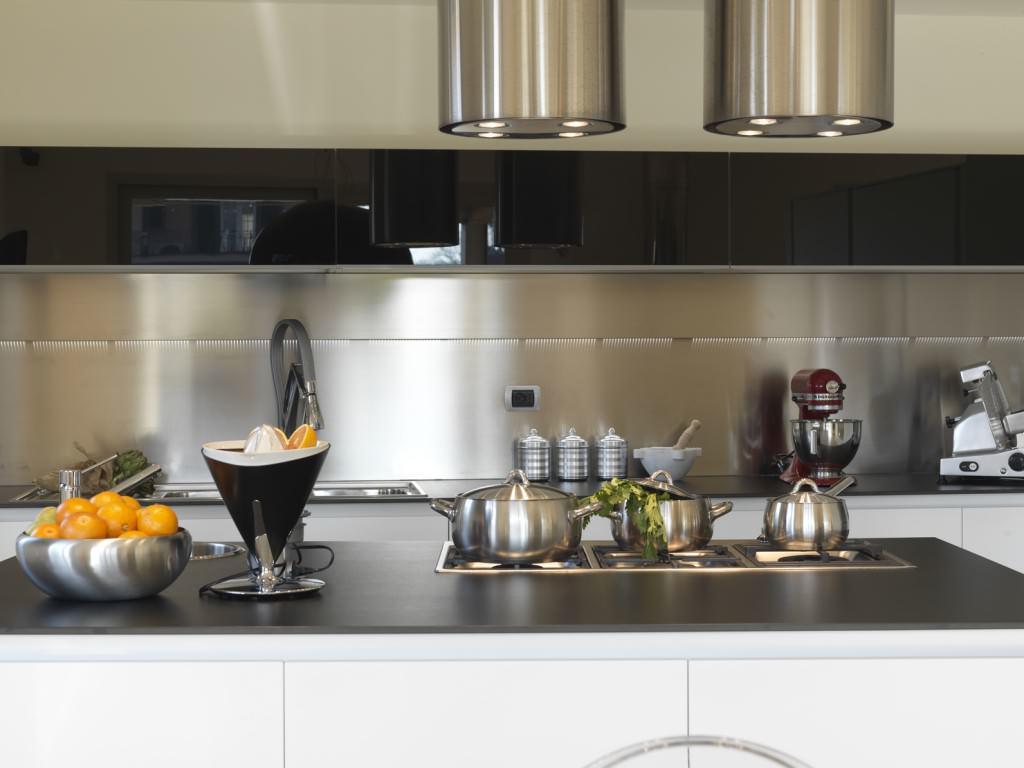
More recently, the decoration of the kitchen apron with such unusual materials for use in this area as stainless steel was considered a rather unusual and bold decision. But paying attention to the positive qualities of the kitchen apron made of stainless steel, many opinions have changed. Stainless steel can create a harmonious consonance with any interior from the style of hi-tech, to the classics, besides it best meets all the requirements for application in this field: metal is not a combustible substance, does not melt, is resistant to minor mechanical damage.
Stainless steel does not lend itself to corrosion, has an elegant appearance, which undoubtedly makes this material one of the most attractive for finishing the apron in the kitchen.
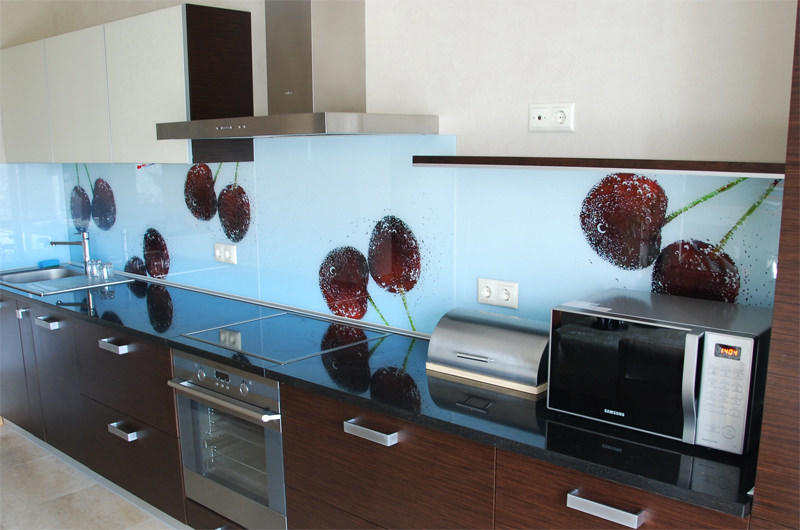
The options for making a kitchen apron are more than enough to choose from. Whichever material you choose, today you can easily select the shade or pattern that will match your taste, the necessary requirements and the overall design of the new kitchen. But when choosing a particular panel, tile or mosaic, you should not forget about the main purpose of the kitchen apron and look at the material you like from the point of view of practicality. Repair of the kitchen is done not for one year, and the kitchen apron is not installed for a month, therefore, in addition to aesthetic qualities, it is necessary to pay attention to the performance characteristics of materials.
Design of an apron for the kitchen (photo)

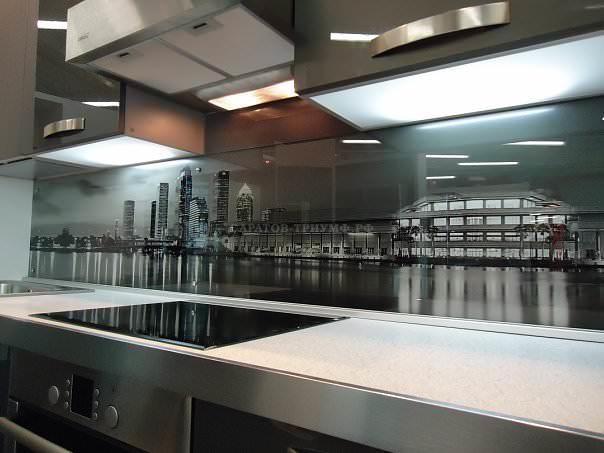
 Tile for apron: a simple solution to a complex kitchen task
Tile for apron: a simple solution to a complex kitchen task
The term "kitchen apron" has recently entered into the vocabulary of interior designers, but it is already firmly entrenched in it, and its popularity with the passage of time only increases. This term is used to designate the surface of kitchen walls near a sink and a plate, covered with some finishing material from those used to decorate kitchens. From an ordinary tile covering apron is characterized by a wide variety of materials, as well as wider design possibilities. In addition, wishing to make an apron for the kitchen with their own hands, with the right choice of material, can safely count on success
When choosing this detail of the kitchen interior, you need to consider several factors, each of which is important in its own way. Utilitarian factors include strength and practicality, which any landlord always pays attention to before or after the decorative-aesthetic factor.
For the general style of this kitchen, the choice of stone as a finishing material is the best option, it is in harmony with furniture and other elements of the interior
Defend the wall behind the sink and stove
The strength of the surface is determined not so much by its ability to withstand mechanical damage, as by its resistance to abrasive or chemical cleaners, which are quite aggressive and can damage a poor-quality surface. The desire to save on such an important part of the interior does not usually lead to anything good, so the idea that an inexpensive chipboard can quite fit as a kitchen apron should be discarded immediately, so that you can not contemplate its scratched surface with barely noticeable remains of paint. It is better to protect the wall behind the stove with metal sides, the recommended height of which should not be less than 15-20 cm, but, as practice shows, there are cases in which this option is not advisable, since low rims do not protect the whole surface of the wall, look a bit rude and inappropriate, not fitting into the overall style of the kitchen.
Practicality or aesthetics?
From the point of view of practicality, it should be taken into account that most of the greasy spots, dirt, scale and burning accumulate just near the slab or sink, so it will be better if this surface is cleaned without any problems. Usually, special problems are associated with textured porous materials such as natural or artificial stone, natural wood or ceramic tiles with a relief surface.
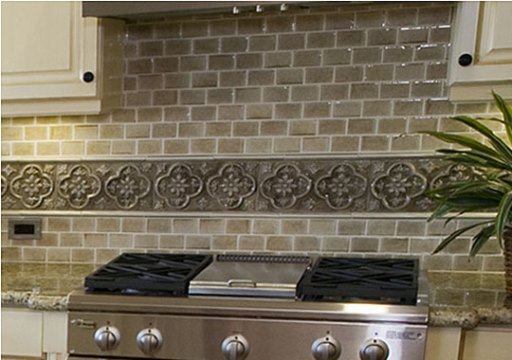
This apron is replete with joints between the tiles, and cleaning the relief curb can be a real test, but the working wall, designed in this way, looks luxurious and stylish
No matter how attractive these materials look and how harmoniously they fit into the interior of the kitchen, specialists do not recommend stopping their choice. The optimum variant of the surface of the kitchen apron is one-piece, smooth, homogeneous, preferably without joints or at least without large intervals between the parts of the coating.
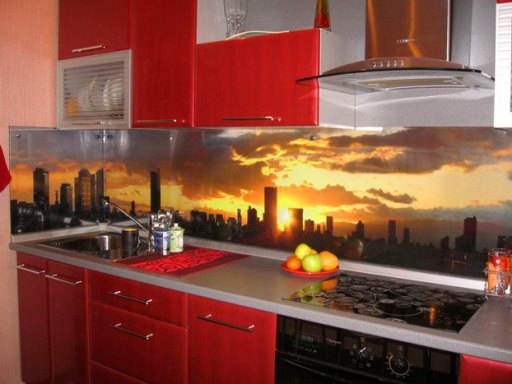
From the point of view of operation, such an apron is remarkable in that dirt is almost imperceptible on its surface, non-uniform in color. Joints between the elements of the apron are not conspicuous, and the original city landscape is another "plus"
If the decorative component of the material is more influential in comparison with strength and practicality, and frequent and careful cleaning of the kitchen does not scare the landlady, then these recommendations can be completely ignored, because beauty is above all!
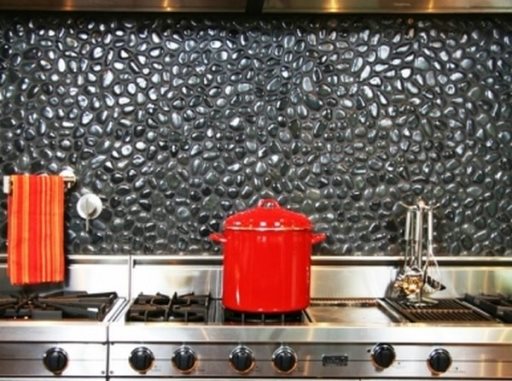
We kill two birds with one stone: on this working wall, finished with natural pebbles of black color, all the beauty of the stone appears and practically no visible dirt
Apron with my own hands or "I want sunflowers!"
Traditionally, the kitchen is considered to be a female territory, and in order for the hostess to be comfortable, her wishes should be taken into account when choosing the design of this room. And it is from this moment begins the most interesting, as the views on the design of the interior of men and women can be radically different. Men prefer single-color and soft color solutions in pastel colors, and women love everything bright, unusual and such that would allocate their kitchen from many others. Therefore, on the eve of the beginning of repairs, the husband can hear peremptory: "I want sunflowers in the kitchen!" Further, confusing and confusing arguments may follow, and maybe not, but the fact remains, and the desire is voiced. And, it does not have to be sunflowers, as the option is considered and the seabed, and the spring forest, and the city landscape and even the gladiators fight. But at this moment the man understands that his life turns into a nightmare: or he will very long contemplate sunflowers in a large area of his apartment, or he can not be forgiven.
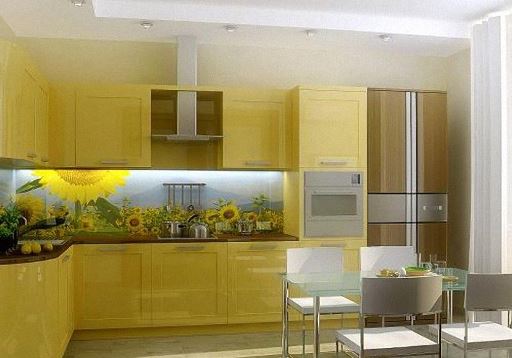
Sunflowers, as one of the scenes for decorating the kitchen, are very popular: such bright and contrasting colors will not get bored, but in large numbers can be annoying. Compromise is achieved by allocating a small area for sunflowers
And then a kitchen apron appears on the horizon, which will help to reach a compromise: modern technologies allow any drawing to be applied to it, and its functional feature is that, occupying relatively little space, it is constantly in front of the owner's eyes working in the kitchen. Thus, she always sees what she wanted, and the kitchen does not turn into an irritating cluster of bright colors. Designers believe that the kitchen is the best place to use the zoning possibilities and get the maximum aesthetic effect. And the desire of women to diversify the interior with splashes of bright details is fully justified and justified - a dull monotonous situation has an oppressive impression, no matter how expensive and quality it may be.
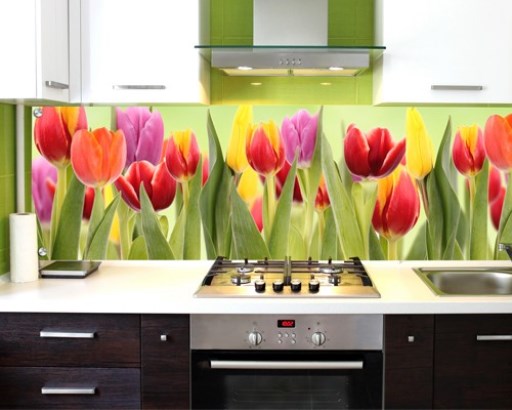
Tulips are traditionally associated with the spring, and their bright saturated colors will add vivacity even in a rainy autumn morning
Advantages and disadvantages of materials for the apron
The most popular and suitable materials for kitchen aprons, from the point of view of a combination of aesthetic component and practicality, are ceramic tiles, glass, mosaic, natural stone, MDF, metal and bricks. Many people are wondering whether it is possible to make a kitchen apron with our own hands. A positive response will largely depend on the choice of the material, because working with MDF will not be particularly difficult even for a beginner, and it is better to entrust the work to a professional master to mosaic panels.
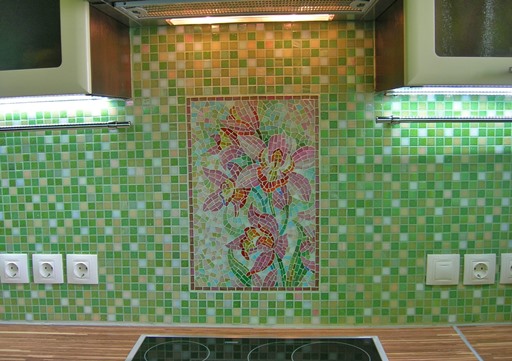
Execution of a mosaic panel with such a variety of shades - work for a professional
Both specialists and amateur masters who decided to make an apron for the kitchen with their own hands unanimously declare that it is easiest to do this by choosing glass as the basis. In addition to its simplicity in operation, this material has other valuable advantages: ease of operation, relative price availability, virtually unlimited number of options for drawing, the ability to quickly replace the bored drawing or damaged element without installing the whole apron.
Important! If the surface of the working wall is supposed to be decorated with a glass apron, it should be perfectly even, otherwise the glass can burst when it is pressed against the wall.
How to install a glass apron
It is the possibility of choosing any pattern that can explain the growing popularity of glass, because the producers of tile, despite the variety of colors, patterns and drawings, are still somewhat limited in this respect. You can, of course, make an individual order, but this will cost much more than the same option with the use of glass.
You can get such coveted sunflowers or any other drawing on your apron in several ways, the most democratic of which is simply to choose suitable wallpaper in the store, which will then be attached transparent elements of the apron. A more expensive way is to order photographic printing in a printing house on an individual project. The most expensive way is to print the selected pattern on a transparent self-adhesive film. In this case, it is also necessary to glue an opaque base film, so that the wall does not penetrate through the drawing.
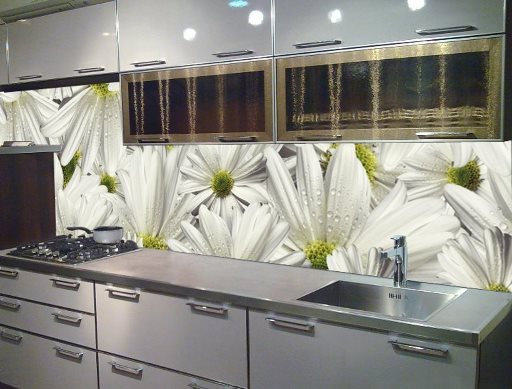
The possibilities of glass aprons in the sphere of decoration are unlimited - any pattern that matches the tastes and preferences of the owners can appear on the kitchen wall
Important! Glass usually has a light greenish shade, especially if its width corresponds to that adopted for the kitchen apron and is not less than 6 mm, so this should be remembered when choosing a pattern.
After that, profiles are attached to the wall (experts recommend choosing U-shaped and L-shaped profiles of aluminum), in which the glass elements of the apron are inserted.
There is one more way of fastening individual elements - using a special fastener for glass with wide hats. To do this, the glass elements must first be drilled with holes for this fixture. It is not recommended to perform such an operation on your own, it is better to ask the specialists of the workshop where the apron was made. By the way, it is necessary to make sure that the ends of the parts are qualitatively polished - so the joints between them will be less noticeable.
Kitchen aprons from MDF
Our desire to do nothing, even in small things, not to yield to our more successful friends and acquaintances sometimes pushes us to take hasty unreasonable decisions. Of course, glass aprons in the kitchen look bright, stylish and fashionable, but this can not be considered a reason to immediately reject, without considering, other options. For example, a coating for a working wall made of MDF has certain advantages that should be taken into account at the time of making the final decision:
- practicality;
- ease of maintenance;
- in the overwhelming case, the possibility of installing an apron without joints and joints;
- durability and durability when used properly;
- ecological compatibility of the material;
- price accessibility.

The MDF plate with a "natural wood" surface looks stylish and noble in this kitchen
The possibility of applying any pattern on the MDF plate, as well as laminating its surface, makes this material even more attractive. In addition, it is desirable not to forget that one plate can be enough for making an apron, and then the overall view of the wall will not spoil the joints, washing and cleaning which so irritate many housewives.
In any case, choosing the material for the apron, one must proceed from the general style of decorating the kitchen and the aesthetic compatibility of the used finishing materials, it is desirable to make full use of the zoning method to achieve the most original result and not be afraid of bold experiments with textures, colors, especially bright and unusual , and different shades.
Video guide for installing an apron from a tile
Special difficulties do not arise when using ceramic tile as an apron material, all the necessary operations can be done with minimal experience in the construction sector.
Photo of an apron in the kitchen
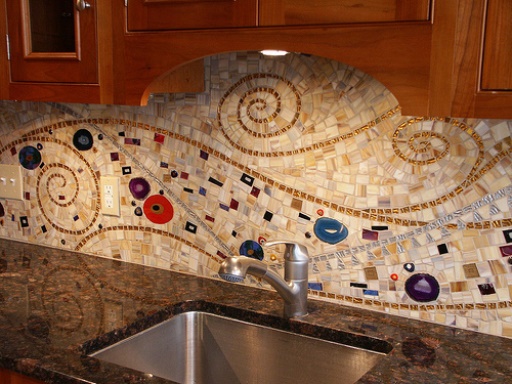
To pick up non-standard fragments of a mosaic so that the pattern is harmoniously entered in an interior, under force it is far not to everyone
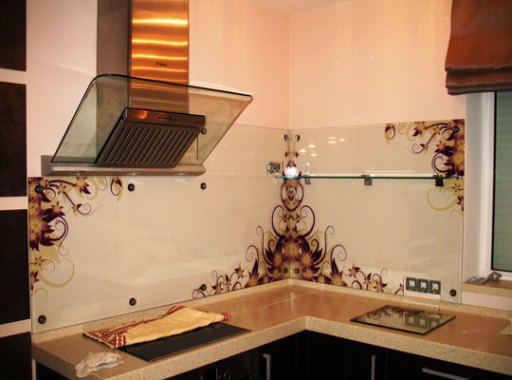
The main decorative element of this kitchen apron is a symmetrical pattern in the color scheme, in harmony with the general background
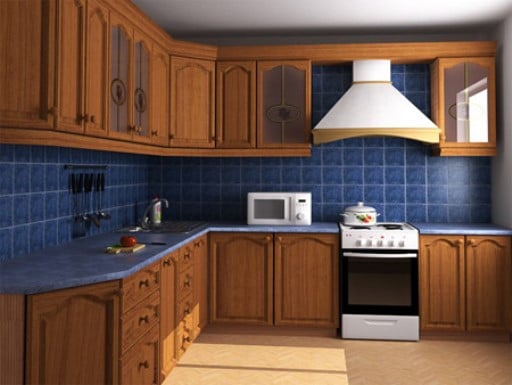
In the interior of this kitchen there are no bright colors, unusual paintings and expensive materials. The necessary effect is achieved due to the noble color combination of brown and blue
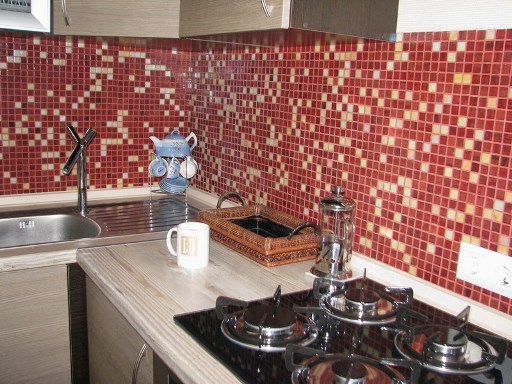
This kitchen apron can not boast of special refinement, however, it looks attractive, and scattered in disorder clusters of light tiles make a note of immediacy in the interior
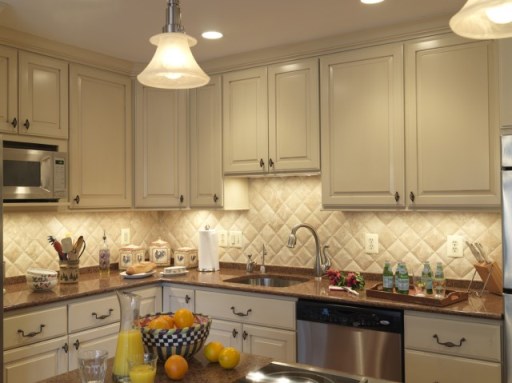
This ceramic tile of light color with a relief surface looks just fine and perfectly fits all the details of the furnishings. Subject to constant care, it will be a real decoration of the room

A somewhat unusual choice of the plot for decorating the kitchen makes it unique, and a successful illumination of the working wall makes a pleasant impression
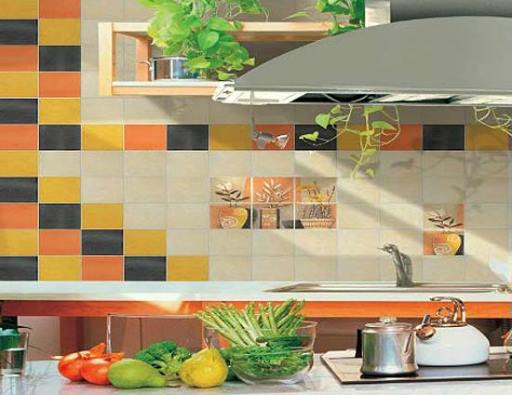
Ceramic tiles, selected in contrasting but harmonious colors, as well as a small panel in the center, make this kitchen attractive and original
If you mount an apron for the kitchen with your own hands, you can save money. In the kitchen, the surface between the top and top drawers gets dirty the fastest. Splashes of water, greasy stains, scum, dross, temperature changes spoil the appearance of the wall.
Installation of an apron from a tile
Kitchen - a place where a family often meets, and sometimes a big company. The uniform atmosphere spoils the mood, but it is necessary that the kitchen look cozy and attractive.
The interior of any room can be varied with bright details, and the kitchen - decorated with an interesting apron.
Even with a small experience of construction work, the amateur master will be able to fulfill his dream. Ceramic tiles, MDF, glass, metal, mosaic - the range of modern materials is huge, but you need to choose it correctly.
An apron for the kitchen with your own hands can be done quickly and efficiently, if you first see the video of the installation and study the photo of the options for decorating the room.
You can demonstrate your taste and talent designer, make the kitchen original, bright and attractive.
The most common option is to lay out an apron for the kitchen from the tile, which is distinguished by its durability and beautiful appearance.
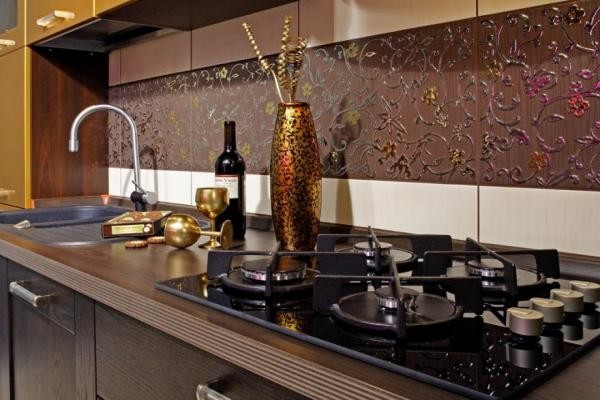
The following materials and tools should be prepared:
- tiles;
- glue;
- a primer;
- grout;
- putty knife;
- gloves;
- crosses for seams.
Work begins with the preparation of the wall surface: it must be perfectly even.
To install the tiles with your own hands, you first need to fix the slats at the correct height so that the tile lies flat. You need to start gluing from the corner and from the bottom.
Using a spatula, apply glue and press the tile firmly against the wall.For the seams to be even, you need to install crosses of 2 pieces per face. Under the outlets the Bulgarian cut out the necessary holes.

Finishing works consist in grouting paste with paste. After 2 days, the tile can be washed.
Apron made of ceramic tiles - a classic option, enjoys well-deserved popularity among buyers.
Mounting of MDF panels
An apron from MDF panels can be quickly mounted by yourself, because the work is not very difficult.
Panels have different shades, they can imitate natural materials and various images. They can be mounted on a regular surface without special preparation, and fastening with self-tapping screws, screws or liquid nails.
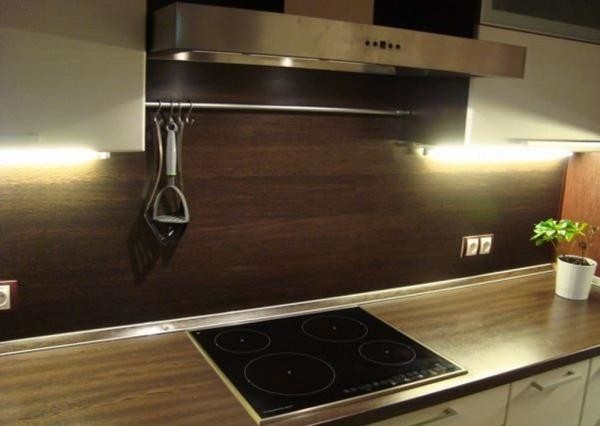
Tools used:
- screwdriver;
- electric drill;
- roulette;
- liquid Nails;
- self-tapping screws;
- plugs;
- putty knife;
- screws.
Liquid nails are applied to the wall and panel, and then tightly press the tile against the wall.
You can fix an apron from MDF with dowels or screws. First set the frame of wooden racks, which are attached with dowels. Then, with the help of self-tapping screws, panels are mounted on the frame. Screws of self-tapping screws are closed with decorative stoppers.
Sometimes in the panels drill holes and fix on the wall with screws. Screws of screws are closed with special plugs.
Installation of skins (glass aprons)
Apron of glass - effective and original decoration of the kitchen interior.
Advantages of glass apron:
- a large number of options;
- simplicity of installation and dismantling;
- long service life;
- visual increase in space;
- affordable price;
- good compatibility with any furniture and kitchen accessories.
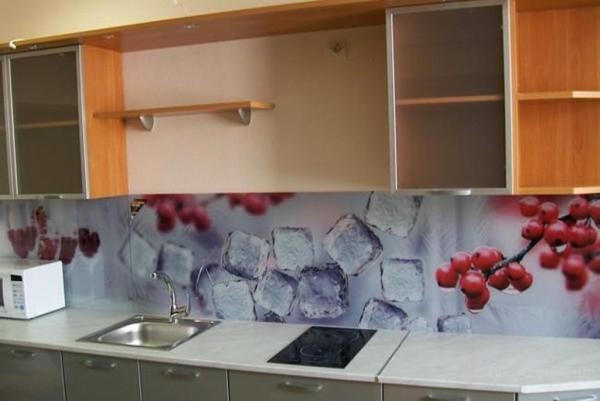
The tempered glass apron, called skinali, is the original and latest invention.
To install a glass apron, the wall should be perfectly even, because the glass can burst on an uneven surface, so the work begins with the wall alignment.
Measurements need to be done very accurately. They need to be removed after placing the upper and lower drawers of furniture, because then it will be difficult to remodel something.
The glass can be mounted on wallpaper or you can order a drawing for your project in the workshop. The most expensive method is to print a drawing on a special self-adhesive film.
For fixing glass panels use screws with wide hats. Drilling holes in glass panels is better not by yourself, but to entrust the work to the specialists of the workshop where the apron was made.
Tempered glass is difficult to process, and skills are needed. The cost of the skin depends on the number of holes for fasteners.
It is important that the ends of the glass panels are well polished and that no seams are visible during installation. Very carefully, it is necessary to cut openings for switches that are usually located in the work area.
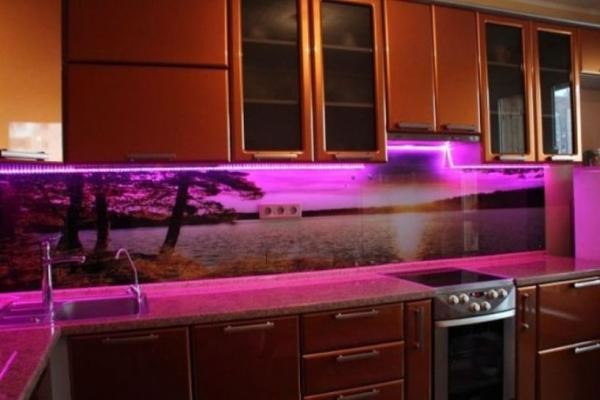
The apron of glass fits well into the kitchen interior. Very impressive looks glass highlighting, which gives the room even more chic. The apron does not require complicated maintenance, it is enough to wipe it periodically with a wet cloth and then with a dry cloth.
Kitchen aprons made of glass give the kitchen a cozy and special color.
To achieve an original result, you need to take into account a number of parameters: the overall design style of the kitchen, the design, the finishing materials of the kitchen set, the compatibility of individual elements.
How to make an apron from a mosaic?
Mosaic can easily identify the working area. It looks impressive, but when stacking it can be difficult. It is important to know the installation features to avoid mistakes.
The main thing is to carefully prepare the wall, to fill in the irregularities, to cover the surface with a surface.

It is better to buy a tile on a reinforced mesh or a self-adhesive mosaic that can be quickly mounted on the defatted surface of the wall.
Now they sell ready-made squares of mosaic that are easily attached to special glue. Do not glue each tile separately. This option greatly facilitates the work process and saves time.
It is necessary to prepare:
- roller;
- level;
- putty knife;
- glue;
- scissors;
- tiles;
- putty;
- a primer;
- grout.
The tile is attached either to special glue, or without it. The glue is applied with a wide spatula, evenly spread over the surface, waiting for the right time and applying a mesh with a mosaic to the wall.
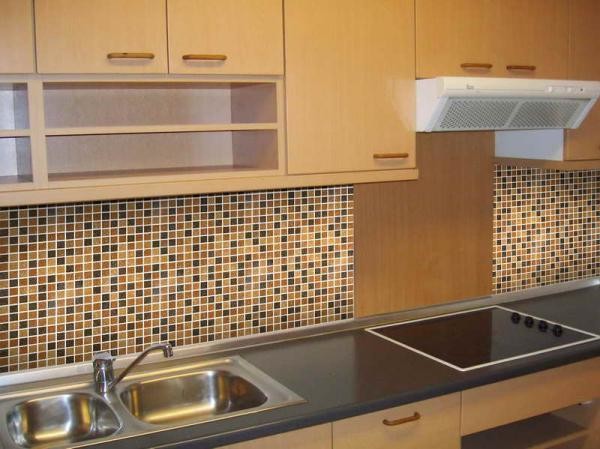
After the material has been laid completely, the seams are rubbed with a small spatula.
Mosaic looks bright and colorful, so you need to use no more than 3 colors, even if it's pastel colors.
This apron has many seams, but it looks modern and stylish.
Summarizing
Kitchen apron can be mounted from various materials. To save money, you can do the work yourself. You just have to be patient, read the installation instructions.
A beautiful and practical apron in the kitchen, installed by own hands, will for a long time please with its uniqueness and uniqueness.
Similar entries:
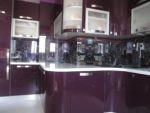
Make a kitchen apron with your own hands will not be difficult. This simple adaptation will not only serve as an ornament for any kitchen, but also protect its walls from greasy traces, fumes and dirty spots near the sink.
To call such a covering a kitchen apron have become relatively recent. Nevertheless, it not only gained considerable popularity, but also acquired significant development. Over time, a huge amount of design solutions appeared and a large number of materials started to be used: tiles, decorative stone, carbonate glass, plastic.
It has long been accepted to make walls near the stove and sink from easily washable, hard and dense materials. This is due to the fact that these zones are most confirmed by contamination during cooking. Fat and soot have the property of eating into the paint, and they can not be withdrawn.
 In such cases, use a kitchen apron, which is not attached firmly to the wall, but simply hangs on it. If necessary, it can be removed without major repairs, and this solution will be much more economical. It will be more expensive if you decide to decide how to sew an apron, using expensive materials.
In such cases, use a kitchen apron, which is not attached firmly to the wall, but simply hangs on it. If necessary, it can be removed without major repairs, and this solution will be much more economical. It will be more expensive if you decide to decide how to sew an apron, using expensive materials.
The advantages of this approach include diversity and the number of design solutions. The brightest is the kitchen apron made of carbonate glass, on which you can apply any pattern or pattern.
In addition, the kitchen apron of glass is a very hard and sturdy surface, which is absolutely not afraid of greasy stains and other dirt and is also easy to clean.
Make an apron with your own hands can be made of ceramic tiles, MDF panels, glass, plastic. Each option has its pros and cons.

Consider these:
- Kitchen apron of tiles, probably the most popular option.
The tile differs in good strength and resistance to various chemical agents, temperature changes. Has a huge selection of different textures and colors. The drawbacks include heavy mounting, which is quite problematic to accomplish without certain skills. - MDF panels allow you to easily, quickly and for moderate money to make a good apron, combined with the wooden finish of the kitchen.
Advantages are low cost, ease of installation, the ability to select the panel tone under the table top and other finishes, the probability of rapid dismantling. But such panels are not able for a long time to resist the various chemical components that are present in the composition of detergents. - About carbonate glass has already been said above.
Of the minuses, he only has the price and complexity in choosing a design. - The plastic has a rather long service life, while it has a beautiful appearance, a small price and ease of installation.
But it is not resistant to fire, and in the process of using it can appear scratches.
Which of the materials to apply, you decide. And how to sew, or to build, an apron, we will consider below.
Mounting the apron by yourself
The most laborious is the installation of ceramic tiles. If we sew an apron of this type, then this process does not do without measurements and miscalculations of the required amount of material. If a person has no idea at all about the basics of this case, it is better to abandon the idea or use the services of a master. He knows exactly how to sew an apron for the kitchen.
But if it was decided to lay the tiles with their own hands, then you need to purchase the tile itself, a special tile glue, a grout with polymer additives, inter-row crosses of 1.5 mm, a notched trowel.
Crosses are needed for smooth seams between tiles, and they are removed immediately before the trowel, and some will have to be cut into wedges.

The procedure for self-assembly is as follows:
- Using a notched trowel we apply glue. This is done below the width, equal to the future apron, and the height of one tile.
- We spread the first row and divide the tiles among themselves cut from the crosses wedges.
- Align the top of the tile, laying under the bottom of the crosses.
- After the glue has completely dried, start spreading the second row in the same way.
- After full stowage, remove the crosses and wipe the seams.
This is the easiest way that a person can use without special skills.
To install the glass yourself will need: glass itself, dowels, screws with washers, support bar, silicone.
First, holes are made 20 mm from the top edge of the glass, and dowels 4-5 mm in diameter are drilled into them to a depth of 50 mm in 30 cm steps. Bottom drill the same holes in the previously installed support bar. After the wall on which the glass will be fixed, and the apron itself is washed, degreased.
The silicone is zigzagged superimposed on the glass sheet "sausage", with the pitch between the loops of 30 cm. The zigzag loops should be vertical.
For further action, at least 3 people will be needed. Two raise the glass and carefully place it on the support beam, the third puts 2 flat screwdrivers on the bar, and how the glass will stand on them. The latter should carefully remove the screwdrivers by pointing the sheet in place. Then by hand it is required to tighten the screws first above, putting washers on them, and then down. After a double drying period, silicone self-tapping screws can be removed.
For MDF and plastic boards, the installation method is the same as for wall lining without the production of a lathing.
At the end, the walls are covered with finishing plaster and put all the furniture in place, the gap between the wall and the countertop is covered with a rim of the same countertop material, a cantilever is inserted between the table and the rim with a flat screwdriver.
Apron from improvised materials
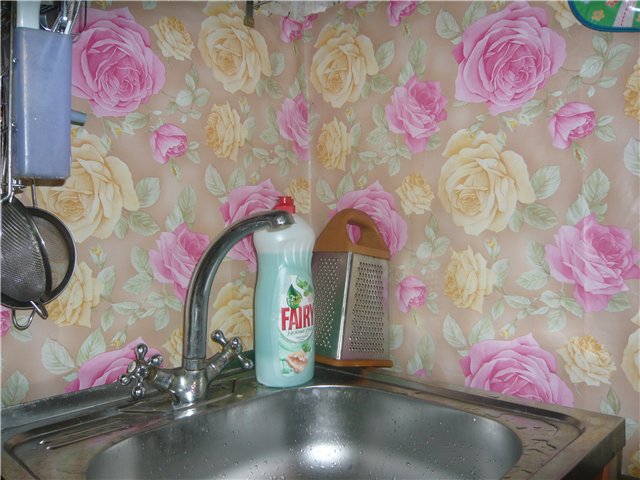 If there is no knowledge of construction matters and do not want to do some unfamiliar work, you can make a kitchen apron from the most accessible materials, for example oilcloth. In this case, you should choose any drawing you like, which will be in harmony with the design of the kitchen itself.
If there is no knowledge of construction matters and do not want to do some unfamiliar work, you can make a kitchen apron from the most accessible materials, for example oilcloth. In this case, you should choose any drawing you like, which will be in harmony with the design of the kitchen itself.
The film is easy to clean and can last a long time, plus it's easier to install. True, this option is suitable only if the wallpaper was used for finishing the entire wall.
The first thing to do is get an oilcloth, prepare a construction stapler, scissors, tape measure.
Roulette is determined by the dimensions with the launch under the countertop, then by these indicators a piece of oilcloth is cut out. We put the pieces to the wall, fasten them together with a stapler. After these manipulations, you can put furniture in place.
From improvised items you can use unnecessary or corrupted CDs. To do this, you need a lot of disks, which you need to cut into several pieces. These parts are folded in mosaic and glued to a clean wall.
When using methods of making an apron with the help of improvised materials, one must understand that such products do not possess such good characteristics as previously described.
In this case it will not matter how to sew an apron. It can still be short-lived.

Kitchen apron is an integral functional and at the same time decorative detail of the interior. In the modern market of building and finishing materials there is a growing demand for kitchen plastic panels. It should be noted that materials with plastic, including laminated MDF, are in an affordable price category, while in performance characteristics there is a significant plus, this is acceptable moisture resistance. Experienced finishers for optimum protection of kitchen walls are recommended by materials made of tempered glass and in many respects superior to tiles. It should be noted that the hardened glass differs unpretentiousness and the possibility of implementing attractive design ideas. Below are the arguments of experts on what kind of apron for the kitchen is better to choose: plastic or glass. It will be useful for you to get acquainted with interesting facts.
How to make an apron in the kitchen professionally?
Correct calculation of apron sizes
When marking the size of the apron, you need to add a couple of centimeters in the right places. This approach is necessary in order to ensure that the protective wall decoration comes not only under the countertop, but under the floor and suspended kitchen cabinets.
lilac design mirror apron in a minimalistic interiorSealing of seams
The kitchen apron should have a smooth smooth surface, exclude visible seams. The fact is that in the joints, as a rule, particles of dirt and moisture penetrate, and the cleaning process is quite labor-intensive. To prevent such problems, use a silicone-based sealant.
mirror apron made of small elements apron of mirror tiles in two rowsAdding a skirting board
The place of contact between the apron and the table top requires proper protection. For this purpose, the plinth is taken, and in addition to it the aforementioned silicone sealant. If you neglect this point, then inevitably getting water in the area where the floor cabinets are installed. In such furniture, the rear walls are usually represented by a woody fibrous sheet, in a humid environment it has the property of abundantly forming a mold, deforming and swelling.
apron from mirror tiles in one row gray-beige glossy apronPractical apron
The kitchen needs the right materials. Traditionally, when developing an apron, unglazed tiles made of ceramics and other porous finishing materials are immediately eliminated. When selecting materials, it should be borne in mind that in the pores the fat, moisture, and complex surface care are firmly fixed, it is a favorable environment for the life of bacteria and dangerous mold.
apron of ceramic tiles with decor apron made of fine ceramic tiles with patternsKitchen apron from glass
Cheap glass is a practical and aesthetically attractive material. This coating has a number of properties, similar to the time-tested tiles. The glass apron is extremely easy to clean of contaminants, moisture adherence and constant temperature changes do not spoil the coating. Purchase of glass material will cost more than tiles, mosaic wall material, chipboard with plastic and MDF. When calculating the cost of an apron, there is also a lot of expensive installation with the use of special fasteners, a specific process for creating holes for rails and sockets.
The apron was best removed using a specially designed fastener for this purpose, without the need for leveling the wall and even removing the old tile. In the case of using to connect the material to the wall of the glue, it will be necessary to adjust the wall to the level, dryness and cleanliness of the surface.
Attaching to the wall of glass material does not provide for dirty work, is carried out quickly. To install the apron, you can proceed only after the kitchen set is installed. Wizards do their work neatly, usually it takes 2 hours.
from glass with large flowers on a dark background of glass with a landscape of the forestThe kitchen apron from glass has the following positive qualities:
- continuous operation without damage;
- excellent moisture resistance;
- easy care.
A quality material with a UV-printed image with good ink has a 5-year warranty. The complete opposite is the budgetary cover-imitation of glass, made of plexiglass with a pattern on the film. It is necessary to emphasize that on the glass apron the fat and water divorces, spots are not noticeable, in this respect the material wins against the background of mosaic or ordinary tiles. Smooth surface without joints is easy to clean, which can not be said about an apron with an abundance of seams.
from glass with white swans on a blue background from glass with green apples and leavesKitchen apron from plastic
Description, surface preparation and material mounting
We continue to talk about which apron for the kitchen is better to choose: plastic or glass. Next, we describe the properties of plastic finishing. This option can be called economical. There are several types of material, the most popular practical boards from MDF, fiberboard or chipboard, covered with a layer of plastic. The surface imitates a tree, a mosaic tile, a stone surface. As an alternative, you can choose another type of plastic apron - polycarbonate. Resistant to mechanical and wet factors, MDF slabs are inferior to artificial or natural stone coverings, mosaic finishes, ceramic tiles, but are sold at an affordable price.
As a base of the apron, wooden blocks protrude, the panels do not adhere to the wall. This implies that surface leveling is not required.
With panels from MDF it is easy to work, installation is accessible to beginners. It does not cause difficulties creating holes for rails and rosettes.
plastic apron with fruit plastic apron with bright colorsMain characteristics of the material
The apron for the kitchen from plastic panels has the following advantages:
- durability of the material;
- moisture resistance;
- uncomplicated care.
It is noticed that high-quality material from MDF and plastic can serve without problems for several years. True, the operating period is less than that of glass and tiles. A plastic apron based on MDF is more resistant to a damp environment than a chipboard panel, but loses in this sense a stone, mosaic, tiled and glass apron. To avoid damage, it is necessary to thoroughly process the edge, to hide the joints with the table top using a plinth. Housewives note a simple care of the surface: a smooth and even apron has no joints, it is well cleaned with a sponge or soft microfiber.
apron made of plastic with large white flowers apron made of plastic with coffee beansIn addition to the options for finishing the kitchen apron, ceramic tiles, natural stone, natural wood, metal, artificial stone or marble, laminate panels, postforming sheets made of particleboard and plastic, mosaic tiles, mirror material, plexiglass and panels with built-in illumination .
